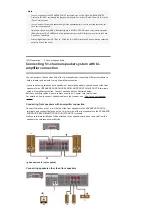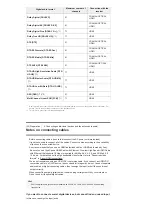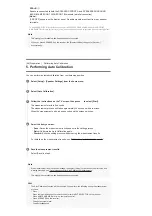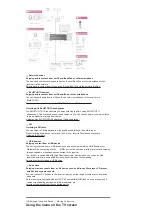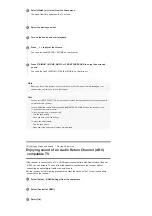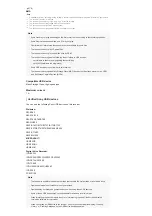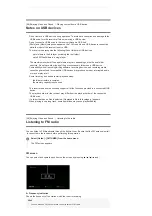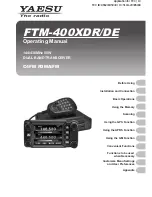
Note
When you use high bandwidth video formats such as 4K/60p 4:4:4, 4:2:2 and 4K/60p 4:2:0 10 bit, be
sure to set the HDMI signal format. For details, see “Setting HDMI signal formats (HDMI Signal
Format).”
Depending on the TV or video device, 4K or 3D content may not be displayed. Check the HDMI
video formats supported by the receiver.
Refer to the operating instructions of each connected device for details.
[37] Preparation
5. Connecting to the network
Connecting the receiver to the network using a LAN
cable (for wired LAN connections only)
The following illustration is an example configuration of a home network with the receiver and a
server.
We recommend that you connect the server to the router with a wired connection.
1920 × 1080p @
59.94/60 Hz
○
-
○
○
1920 × 1080p @ 50 Hz
○
-
○
○
1920 × 1080p @
29.97/30 Hz
○
○
○
○
1920 × 1080p @ 25 Hz
○
○
○
○
1920 × 1080p @
23.98/24 Hz
○
○
○
○
1920 × 1080i @
59.94/60 Hz
○
○
○
○
1920 × 1080i @ 50 Hz
○
○
○
○
1280 × 720p @
59.94/60 Hz
○
○
○
○
1280 × 720p @ 50 Hz
○
○
○
○
1280 × 720p @
29.97/30 Hz
○
○
○
○
1280 × 720p @
23.98/24 Hz
○
○
○
○
720 × 480p @ 59.94/60
Hz
○
-
-
-
720 × 576p @ 50 Hz
○
-
-
-
640 × 480p @ 59.94/60
Hz
○
-
-
-
If you use YCbCr 4:4:4/YCbCr 4:2:2/RGB 4:4:4 or YCbCr 4:2:0 Deep Color (Deep Colour) (10 bit or 12 bit) of
these video formats, we recommend you to use Premium High Speed HDMI Cables with Ethernet that support 18
Gbps and be sure to set the HDMI signal format to [Enhanced format] in the [HDMI Settings] menu. For details,
see “
Setting HDMI signal formats (HDMI Signal Format)
.”
*1
If you use Deep Color (Deep Colour) (10 bit or 12 bit) of these video formats, we recommend you to use
Premium High Speed HDMI Cables with Ethernet that support 18 Gbps and be sure to set the HDMI signal
format to [Enhanced format] in the [HDMI Settings] menu. For details, see “
Setting HDMI signal formats (HDMI
.”
*2


